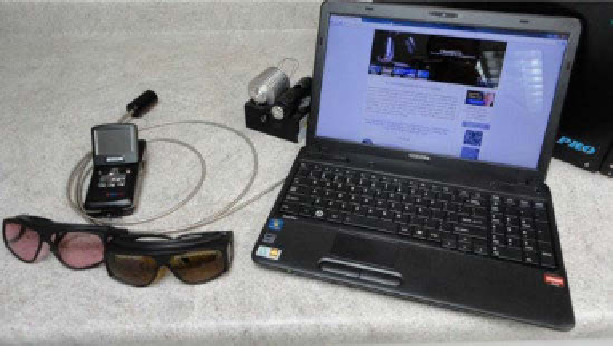Biomedical Engineering Reference
In-Depth Information
FiGure 12.1
Pandia
®
system includes a 20 W 808 nm diode laser with fiber-optic delivery,
injectable Ntracker™ gold nanoparticle reagent (not shown), a thermal imaging camera, and
laser safety goggles.
hand, the statistics for cancer development as our pets live longer lives are even
grimmer: approximately 45% of pets over ten years of age will be diagnosed with
the disease [1]. Of the 74 million dogs and 90 million cats in U.S. households, it is
estimated that 4 million dogs and 4 million cats will develop cancer each year [2, 3].
Current treatment methods for companion animals diagnosed with many types of
cancers are similar to those for humans. Primary therapeutic regimens include one
or more of the following: surgical removal, burning, freezing, radiation therapy,
chemotherapy, hormone therapy, and immunotherapy. These treatments have
varying degrees of success, depending on a wide array of factors, including stage of
the disease at diagnosis, location of the tumor(s), age and health of the animal, and
many other conditions. Additionally, conventional treatment with chemotherapy
and radiation is toxic with many side effects. Pet owners are increasingly demanding
treatments for their companions that will improve their outcome and extend their
life. For cancers that do not respond to traditional therapies or are too difficult to
treat by standard methods such as recurring soft tissue sarcomas, an approach that
will significantly improve the prognosis for the animal, and thus for their owners, is
desperately needed.
Thermal ablation of tumors is one such treatment that holds the promise of
radically changing the outcome for many stricken companion animals while
offering hope to their owners desperate for an approach that gives the very real
possibility of both longer life and improved quality of life for their pets. Thermal
ablation of tumors has the potential for a generalized method of cancer therapy
with less chance of side effects from the treatment [4-6]. Further, there is solid
clinical evidence that heat treatment potentiates both chemotherapeutics and radi-
ation [5-8]. In particular, heat treatment inhibits dNA replication and damage
repair, preferentially kills nutrient-deficient cells, increases tumor blood flow and

Search WWH ::

Custom Search